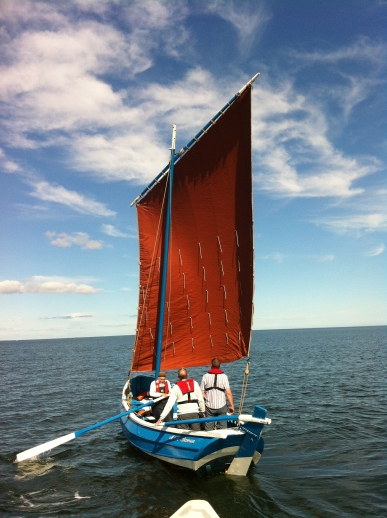
PEGGY – Built 1924.
At 100 years she is believed to be the oldest fully restored Northumbrian coble.
SIGNIFICANCE STATEMENT – National Maritime Museum; small boat register
1. What is the vessel’s ability to demonstrate her physical fabric?
Peggy has not been compromised by alteration from her original build specification. Overall dimensions are 28′ long, 7′ 6″ beam and 2′ draft, though the rudder reaches 4′ below water level. Repairs and restoration have been undertaken to maintain original standards and materials. Framing is 60% original, planking 60%, masts and spars are replacements. Engine and gearbox have been replaced and the present engine is a Lister of uncertain age but probably dating from the 1950s.
The paintwork replicates that typically carried by this type of coble on the coast of Northumberland throughout the twentieth century. It has not been possible to obtain archive photographs or other evidence for the painting of this boat during her period of use in the fishing industry.
2. What are the vessel’s associational links for which there is no physical evidence?
Peggy, was built by the Harrison yard at Amble in 1924 “on spec” during a slack period. Unusually (for a coble) she was sold for pleasure use, the purchaser being a Mr Hall, resident of Beadnell in Northumberland. For this purpose Harrison’s fitted a cabin but it was not long before she lost her pleasure boat fittings, when sold on for fishing to Robert Rutter of Seahouses, as a typical coble with engine and auxiliary sail and registered BK7. She later worked back at Beadnell, then at Amble where she became BH177 and renamed Glad Tidings. Later in her history Peggy moved to Sunderland.
As a fishing coble she worked long lines, salmon nets and pots for crab and lobster. Upon leaving the fishing industry Peggy was used as a pleasure boat at Hartlepool, before being bought in poor condition by an NFHT enthusiast in 2007. Restoration was undertaken in 2008 at the boatyard then owned by Fred Crowell, at South Shields. Further comprehensive restoration led by Dave Parker was completed in 2017 by NFHT and NEMT volunteers at the same boatyard. Now kept on the river Tyne and in almost original condition she is in the ownership of Northumbrian Fishing Heritage Trust.
3. How does the vessel’s shape or form combine and contribute to her function?
Peggy is a typical Northumbrian coble of the kind used and built until the 1950s, to traditional specification similar to the sailing vessels of previous centuries. The design gradually evolved as engines became more efficient and fishermen sought cobles of greater proportions and versatility. These later cobles were built until the 1980s. The type, of which Peggy is representative, was built in large numbers and at one time several ports on the east coast had many such boats. Originally beach boats, their shape reflects many of the design and construction methods common in previous centuries. It is important to note that the hull design contains build elements of wooden North Sea craft of the sixth century and of British hide covered craft. – although such origins require further research.
There is no centre keel as such, though a part keel commences at the forefoot and extends almost to a point amidships. For the aft two thirds of the boat – which is largely flat bottomed – there are two droughts or bilge keels upon which the vessel rests on the beach. Lack of a keel is compensated by the stability afforded by a very deep forefoot and a deep detachable rudder. The rudder is mounted outside a transom that rakes at 45 degrees. Peggy’s old rig was carefully surveyed from photographs and drawings of similar cobles and faithfully reproduced. The mast is stepped forward in the boat and rakes aft so that the dipping lug sail is hung centrally. The mast therefore does not take up valuable space amidships. On beaching, cobles were usually floated onto a pair of wheels on a low slung axle to be led off the beach to a place of refuge. Peggy normally resides at St Peter’s Marina and is used for training in traditional coble sailing skills, gatherings and visits to other ports.
